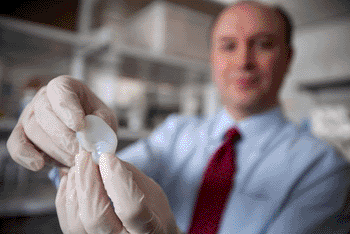Bioengineered Replacement Ears Look, Behave Like the Original
By LabMedica International staff writers
Posted on 05 Mar 2013
Physicians have effectively constructed a duplicate of a living human ear that appears and acts the same as the real thing. Researchers believe their bioengineering technology will be effective in the long search by scientists and physicians to provide normal looking “new” ears to children born with congenital ear deformities.Posted on 05 Mar 2013
In their study, published February 20, 2013, in the journal PLOS ONE, the researchers revealed how three-dimensional (3D) printing and new injectable gels made of living cells can be used to fashion ears that are identical to a human ear. Over a three-month period, the length of the study, these flexible ears progressively grew cartilage to replace the collagen that was used to help mold them.

Image: Larry Bonassar, Associate Professor of Mechanical Engineering, holds a fabricated ear printed with a 3D printer in his lab at Cornell University's Weill Hall (Photo courtesy of Lindsay France/Cornell University Photography).
“I believe this will be the novel solution reconstructive surgeons have long wished for to help children born with absence or severe deformity of the ear,” said the study’s co-lead author, Dr. Jason Spector, director of the Laboratory for Bioregenerative Medicine and Surgery (LBMS) and associate professor of surgery of plastic surgery in the department of surgery at Weill Cornell Medical College (New York, NY, USA), and an adjunct associate professor in the department of biomedical engineering at Cornell University (Ithaca, NY, USA). A bioengineered ear replacement like this would also help individuals who have lost part or all of their external ear in an accident or from cancer.”
Replacement ears are now constructed using compounds that have a Styrofoam-like consistency, or sometimes, surgeons will build ears from rib that is harvested from a young patient. “This surgical option is very challenging and painful for children, and the ears rarely look totally natural or perform well,” stated Dr. Spector, who is also a plastic and reconstructive surgeon at NewYork-Presbyterian Hospital/Weill Cornell Medical Center. “All other attempts to ‘grow’ ears in the lab--including one 1997 study widely publicized by photos of ears implanted on the backs of mice—have failed in the long term.”
This Cornell bioengineered ear is the best to date in appearing and acting like a natural ear, the researchers reported. Moreover, the process of making the ears is fast—it takes only one week at most. “This is such a win-win for both medicine and basic science, demonstrating what we can achieve when we work together,” said the study’s other lead author, Dr. Lawrence J. Bonassar, associate professor and associate chair of the department of biomedical engineering at Cornell University.
The deformity that both Dr. Spector and Dr. Bonassar are trying to remedy is microtia, a congenital deformity in which the external ear is not fully developed. Dr. Spector and Dr. Bonassar have been collaborating on bioengineered human replacement parts since 2007, and Dr. Bonassar has also been working with other Weill Cornell physicians. For example, he and Weill Cornell’s neurologic surgeon Dr. Roger Härtl are currently testing bioengineered disc replacements using some of the same methods demonstrated in this current study. The researchers specifically work to develop replacements for human structures that are primarily made of cartilage—spine, nose, joints, trachea—because cartilage does not need to be vascularized with a blood supply in order to survive.
To make the ears, Dr. Bonassar and his colleagues first took a combination laser scan and panoramic photo of an ear from twin girls, which provided a digitized 3D image of their ears on a computer screen. That took 30 seconds, and did not involve any ionizing radiation. The researchers then converted that image into a digitized “solid” ear and used a 3D printer to build a mold of the ear. The researchers noted that the mold is similar to a box with a hole in the middle that is in the shape of the mirror image of the ear.
The scientists injected animal-derived collagen into that ear mold, and then added almost 250 million cartilage cells. The collagen acted as a scaffold upon which cartilage could grow. Collagen is the chief structural protein in the body of every mammal. Animal-based collagen is frequently used for cosmetic and plastic surgery. This high-density collagen gel, which Cornell researchers developed, looks similar to flexible Jell-O [a gelatin dessert] when the mold is removed.
“The process is fast,” Dr. Bonassar said. “It takes half a day to design the mold, a day or so to print it, 30 minutes to inject the gel and we can remove the ear 15 minutes later. We trim the ear and then let it culture for several days in a nourishing cell culture medium before it is implanted.”
During the three-month observation period, the cartilage in the ears grew to replace the collagen scaffold. “Eventually, the bioengineered ear contains only auricular cartilage, just like a real ear,” remarked Dr. Spector. Dr. Spector reported that if all future safety and effectiveness testing work out, it might be possible to try the first human implant of a Cornell bioengineered ear in as a short time as three years. “The innovation in this study is two-fold,” stated Dr. Bonassar. “The use of imaging technology to rapid and accurately make the shape of the ear implant is new, as is the high-density collagen gel for the mold.”
“These bioengineered ears are highly promising because they precisely mirror the native architecture of the human ear,” Dr. Spector concluded. “They should restore hearing and a normal appearance to children and others in need. This advance represents a very exciting collaboration between physicians and basic scientists. It is a demonstration of what we hope to do together to improve the lives of these patients with ear deformity, missing ears, and beyond.”
Related Links:
Weill Cornell Medical College














